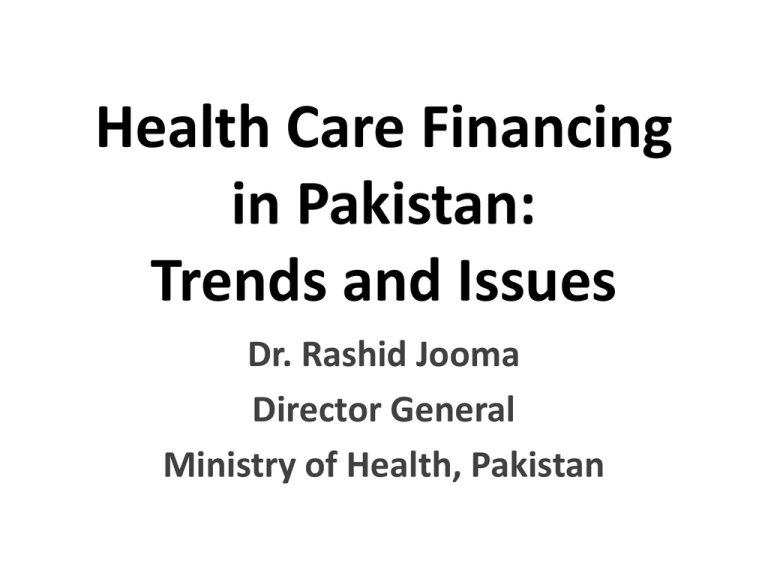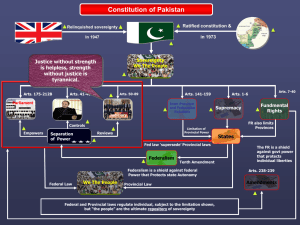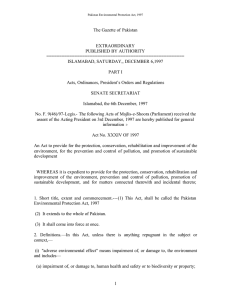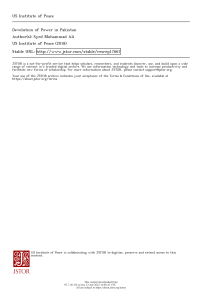Dr. Rashid Jooma
advertisement

Health Care Financing in Pakistan: Trends and Issues Dr. Rashid Jooma Director General Ministry of Health, Pakistan Purpose of a Sound Health Care Financing Policy Beyond “how much should we spend…” A sound HCF policy should look at: • The Overall need and Available funds • How money flows to ensure the system reaches its objectives • Creating incentives to enhance health care delivery • Provide social protection against routine and catastrophic health care expenses The Current Government Setup Policy Budget Surveillance M&E Reporting Oversight Funds Federal Direct Oversight M&E District Reporting Oversight Funds Provincial Direct Implementation M&E Current Health Care Spending • • • • Total: Rs 152 billion (2% of GDP) Or about USD 17 per capita Government contribution is about a quarter Reflects only about a 50% increase over the past 15 years (when adjusted for inflation and population growth) Where it goes • Government: prevention, curative care and infrastructure • Private sector and NGOs: mostly curative care Some current restraints • Limited revenue collection (<15% of GDP) • Limited revenue collection by provincial or district governments • Distinction between recurrent and development budgets, sometimes with management of each with different depts • Within sub-units (eg hospitals) different things are paid from different funding sources • Under utilization of allocated funds Is increased funding needed… • Absolutely! • However, this is not the final answer • Health outcomes are not well correlated with health spending • In fact setting a total as a target may not be very helpful • Equally important to 1. prioritize funding 2. design technically sound interventions and 3. monitor results that are geared towards effective and equitable targets General Suggestions • Need an overarching plan that looks at the overall health needs to establish the funding envelope (and also assigns deliverables and responsibilities for different stakeholders) • Making sub-units (for e.g. districts or even clinics) accountable for their budgets and their deliverables • Definition of “minimum essential” packages • Assign accountability and responsibility for services • Financial and budgetary implications (rewards or otherwise) tied to quality of services provided • M&E framework including results and finances Raising Adequate funds • • • • Taxation Earmarking Approach external donors Allowing provincial or local revenues to go directly to health locally • User fees Pooling Risk • Catastrophic health insurance is being provided in Pakistan via the Rural Support Networks • Government leverages expenses related to natural disasters • Government increases coverage and payments for expensive healthcare such as hospitalization, esp when these payments are pro-rated acc to incomes Equitable Provision of Services • Pro-rate user fees and other expenses acc to income of clients • Conditional Cash Transfers (CCT) to attract clients to prevention services and as social support for the poorest • Support funds for indigent care (zakat) • NGO and philanthropic support Efficient Provision of Services • • • • • Adequate funding for what is planned Timely and efficient disbursement of funds A results monitoring system Pilot trials of Results based financing Delegate control over budgets, implementation as well as responsibility to local implementers • Local community involvement in planning and then monitoring services Role of non-state actors • Providers of quality care (Rural Support Networks, charitable hospitals/ clinics) • Providers of essential services (Edhi) • Providers of social safety nets (Edhi, other NGOs) • Providers of employment or employment/ income generation (include micro credit, vocational training) • Piloting new health care models (AKHS) • Funding some care





